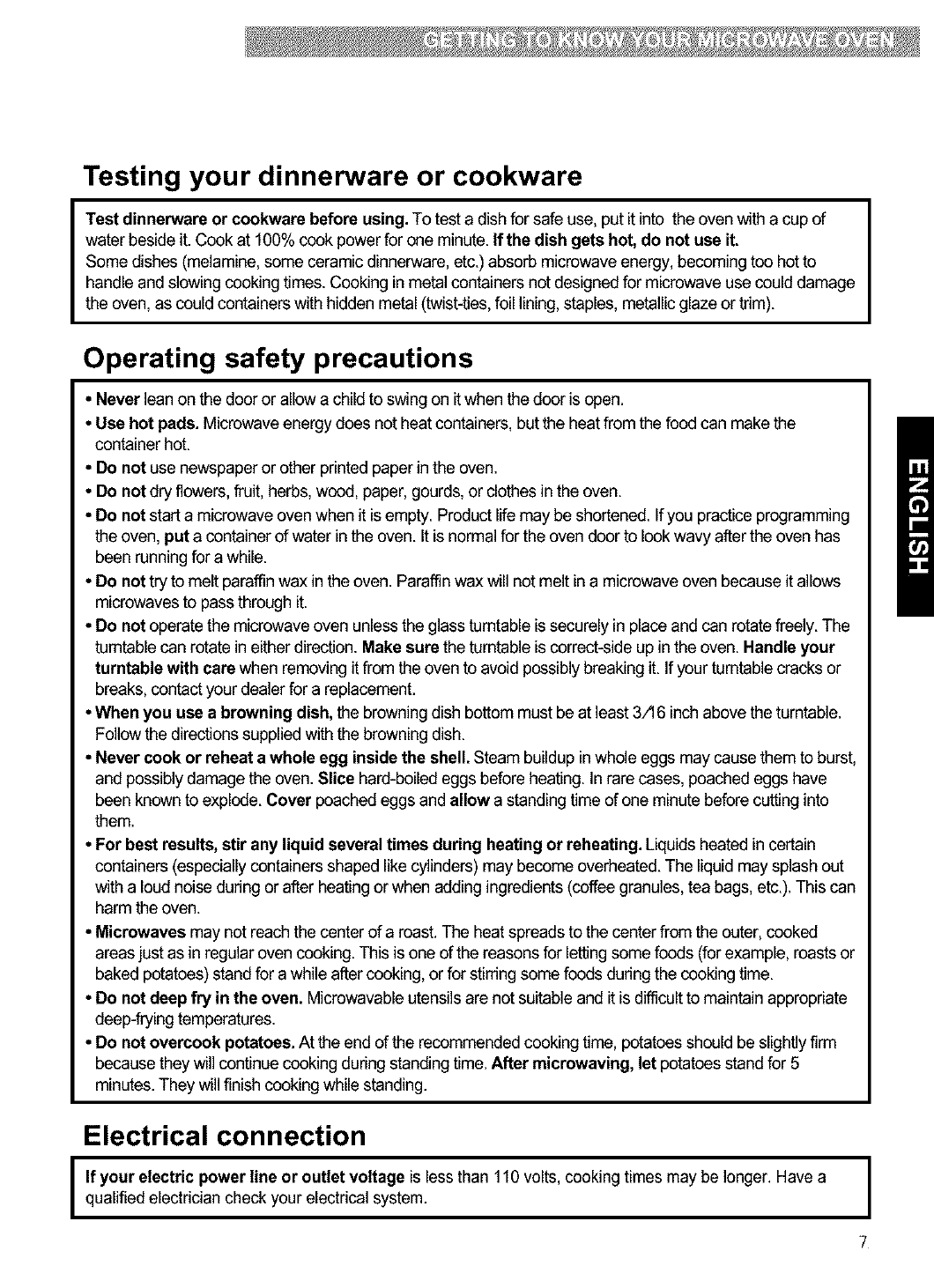
Testing your dinnerware or cookware
Test dinnerware or cookware before using. To test a dishfor safe use, put itinto the oven with a cup of
water beside it. Cook at 100% cook powerfor one minute.If the dish gets hot, do not use it.
Some dishes (melamine, some ceramic dinnerware, etc.) absorb microwave energy, becoming too hotto
handle and slowing cooking times. Cooking inmetalcontainers not designed for microwave use could damage
the oven, as could containers with hidden metal (twist-ties,foil lining,staples, metallicglazeor trim).
Operating safety precautions
• Never lean on the door or allow a childto swing on itwhen the door is open.
• Use hot pads. Microwave energy does not heatcontainers, butthe heat from the food can make the
container hot.
• Do not use newspaper or other printed paper in the oven.
• Do not dry flowers, fruit, herbs, wood, paper,gourds, or clothesin the oven.
• Do not start a microwave ovenwhen it isempty. Product lifemay be shortened. If you practice programming
theoven, put a containerof water inthe oven. Itisnormal for the oven door to look wavy after the oven has
been running for a while.
• Do not try to melt paraffin wax in the oven. Paraffinwax will not melt ina microwave oven because it allows
microwavesto pass through it.
• Do not operate the microwave oven unlessthe glass turntable issecurely in place and can rotatefreely. The
turntable can rotate in either direction.Make sure the turntable is correct-side up in the oven. Handle your
turntable with care when removing itfrom theoven to avoid possibly breakingit. If your turntable cracks or
breaks,contact yourdealer for a replacement.
• When you usea browning dish, the browning dish bottom must be at least 3A6 inchabove the turntable.
Follow the directionssupplied with the browning dish.
• Never cook or reheat a whole egg inside the shell. Steam buildup inwhole eggs may cause them to burst,
and possiblydamage the oven. Slice hard-boiled eggs before heating. In rare cases, poachedeggs have
been known to explode. Cover poached eggs and allow a standing time ofone minute before cutting into
them.
• For best results, stir any liquid several times during heating or reheating. Liquids heated incertain
containers(especially containers shaped like cylinders) may become overheated. The liquid may splash out
with a loud noise during or after heating or when adding ingredients (coffee granules, tea bags, etc.). This can
harm theoven.
• Microwaves may not reach the center of a roast.The heat spreads to the center from the outer, cooked
areasjust asin regular oven cooking. This is one of the reasons for lettingsome foods (for example, roasts or
baked potatoes)stand for a while after cooking, or for stirring some foods during the cooking time.
• Do not deep fry in the oven. Microwavable utensilsare not suitable and it isdifficultto maintain appropriate
deep-fryingtemperatures.
• Do not overcook potatoes. At the end of the recommended cooking time, potatoes should be slightly firm
because they will continue cooking during standing time. After microwaving, let potatoes stand for 5
minutes. They will finish cooking while standing.
Electrical connection
I If your electric power line or outlet voltage isless than 110 volts, cooking times may be longer. Have a
qualified electrician check your electrical system.
I


















